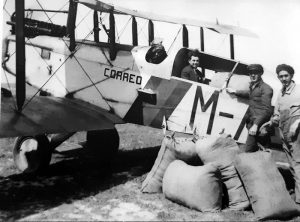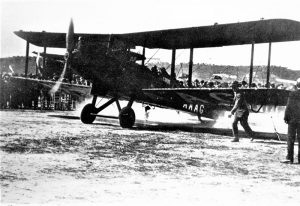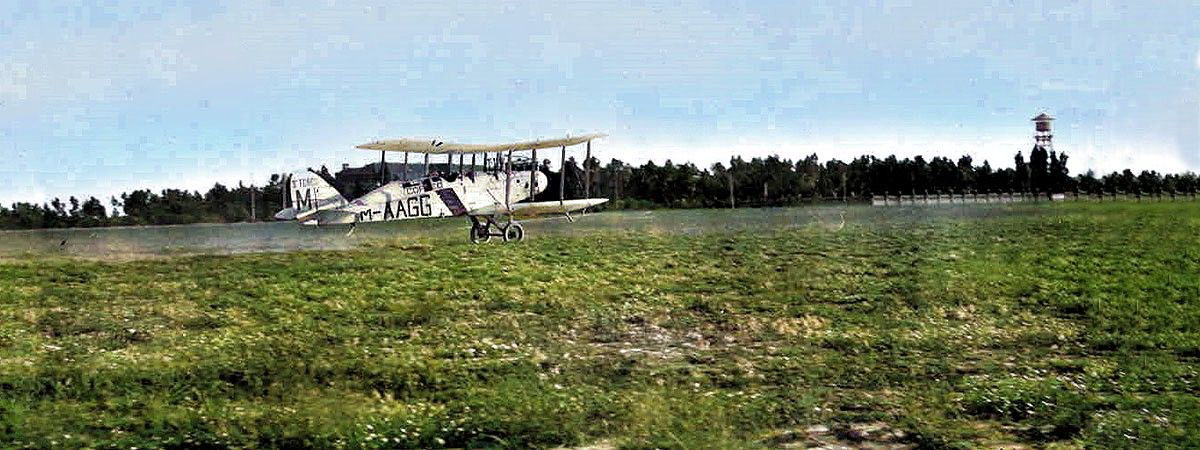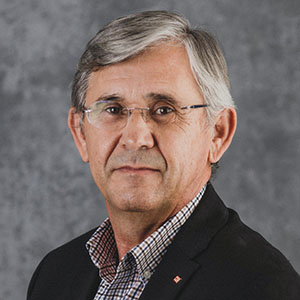On September 1, 1919, when the Compagnie de Lignes Aériennes Latécoère established its air services between Toulouse, Barcelona, Alicante, Málaga and Casablanca, the irritation of the Spanish Government and even King Alfonso XIII himself was more than evident – as it was a French company.
Spurred by the situation, the Spanish Government began the process of creating an airline in our country, an initiative the Postmaster General was quick to take advantage of to provide fresh stimulation for the deficient land routes that were holding back the postal service.
With this aim, three proposed airmail lines were launched, of which only the Seville-Larache route managed to make it – more due to military interests in the Moroccan Protectorate than to air transport needs between the two cities.
One hundred years of airline history in Spain offers a surprising portrait of a market that has evolved to benefit millions of passengers every year.
A preliminary selection reduced the seven bidders for the Seville-Larache route down to just two companies: Talleres Hereter and the Spanish Air Transport Company (Compañía Española de Transportes Aéreos, in Spanish). The official head of the latter was Manuel Aznar, director of the Francophile newspaper El Sol, in association with Pierre Latècoére and Beppo Massimi, Latècoére’s partner, the new company’s managing director.
On January 23, 1921, the commission evaluating the bidding process decided the line should be awarded to Manual Aznar’s company. However, the Talleres Hereter representative, Málaga engineer Jorge Loring, was quick to protest in Madrid’s political circles. He leveraged his good relationships with high level government officials as Latècoére’s involvement in the project could jeopardize the condition that the company had to be Spanish. This was a patriotic position promoted at all levels of government and even the crown.
This is how Talleres Hereter, from Barcelona, was awarded the contract at the end of 1920 in unstable financial circumstances that ended in bankruptcy months later. Jorge Loring, its technical director, tried to save the concession of the Seville-Larache postal line by contacting Fernando Sartorius, Count of San Luis, who was a Navy officer, a military pilot and one of the most influential members of Spain’s Royal Aeroclub. Sartorius was not opposed to joining the project and together with Loring began to create a new company that could replace Talleres Hereter using a legal device to transfer the rights of the postal airline contract to the new company.
 This new company was named the Spanish Air Traffic Company (CETA, in Spanish). In addition to Loring and Sartorius, its partners included Felipe Comabella, Álvaro Muñoz and Bernardino Melgar Abreu, Marquis of San Juan de Piedras Albas, who provided the bulk of the capital required to start the company.
This new company was named the Spanish Air Traffic Company (CETA, in Spanish). In addition to Loring and Sartorius, its partners included Felipe Comabella, Álvaro Muñoz and Bernardino Melgar Abreu, Marquis of San Juan de Piedras Albas, who provided the bulk of the capital required to start the company.
CETA was established on June 25, 1921. The company’s objective was to operate airlines, build aviation and ballooning devices and import/export aviation-related equipment. The company’s capital stock was set at one million pesetas, divided into two thousand shares of five hundred pesetas each. It was based in Madrid at 39 Reina Street.
The next step, after launching CETA, was to organize the operational aspects. Jorge Loring, as CEO, also managed the company and sought the collaboration of Eduardo Barrón Sotomayor as technical director and Juan Viniegra Aréjula as head of services.
When it came to acquiring aircraft, CETA chose the famous DH.4 and DH.9 bombers, named after designer Geoffrey de Havilland, owner of De Havilland Aircraft Ltd.
De Havilland agreed to modify the DH.9s that CETA ordered for airline service. AT&T had already done this, removing the Scarff mount for the observer’s machine guns and adding a seat in front of the pilot for a second passenger. De Havilland later created space for a third passenger by expanding the observer area in the new model DH.9C.
The de Havilland DH.9C had a wingspan of 12.92 meters and was 9.3 meters long and equipped with a Puma engine with 6 vertical cylinders and 240 HP, sufficient for a 250 kg payload.
On September 19, 1921, the first two DH.9Cs were ready for delivery to CETA. This took place at London’s Croydon Airport with factory numbers 11 and 12, and licence plates M-AAAG and M-AAGA. The planes flew from London to San Sebastián (Spain) piloted by Englishmen Alan Cobham and F.J. Ortweiler. The third plane – the M-AGAA – arrived in San Sebastián a few days later October 7, piloted by Charles Barnard.

The aircraft went through import customs in the Basque city of San Sebastián and then continued to Madrid after paying 1,000 pesetas – the equivalent of 6 Euros – in duties for each plane.
On the flight from San Sebastián to Madrid, bad weather forced pilots Cobham and Hatchett to make a precautionary landing next to one of the towns on the way. Curious locals there wouldn’t stop fiddling with every piece of the plane until the local priest intervened – before any damage was done.
After spending the night at the priest’s home, Cobham tried to compensate him for his kindness with a 50-franc note. The priest, however, flatly refused, and the pilots continued their journey to Seville, Spain.
The airline had to be inaugurated in haste due to political tension in the Moroccan Protectorate related to that summer’s events in the town of Annual. This made it possible for CETA to obtain a provisional flight permit and then complete the approval process required for a license later, in December, in Seville.
Spanish commercial aviation is born
In mid-September 1921, the Postmaster General gave orders for handling new air postal services. The price for mail was set at 50 cents per 20 grams or fraction of weight, up to 500 grams. In addition to the “Air Mail” surcharge, all air shipments were to be labelled “Seville-Airplane”.
On October 10, the Postmaster General Deputy Director, Mr. Meruendano, published the airline’s first schedule, with the first planes leaving Seville at 11:00 a.m. and arriving in Larache at 12:45 p.m. The second plane left Larache at 3:00 p.m. and arrived in Seville at 4:45. This allowed one hour and forty-five minutes to travel slightly less than three hundred kilometres from Seville to Larache. This first Spanish airline was to begin service on October 13, 1921.

CETA’s initial staff in Seville consisted of one person in administration, three drivers, three pilots and a few mechanics and carpenters, with a total of barely twenty people. The Seville City Hall gave CETA a strip of land 700 x 300 meters south of the Dehesa de Tablada, sharing the airfield with the military Air Base. There, CETA initially took two large wooden crates, the kind used for transporting aircraft, and fitted them with doors and windows. One would be the warehouse for engines and spare parts, and the other would be the waiting room with a pilot’s locker room and a small workbench. The company’s offices were at 30 Juan Rabadán Street, Seville. The first CETA pilots were Englishmen Jack Hatchett, Sidney St. Barbe and C.F. Wolley Dod.
The airline was inaugurated on October 15, 1921, and those in attendance included the Count of Colombi, General Director of the Postal and Telegraph services, General Francisco Echagüe, head of Military Aviation, Federico Leal, head of Air Postal Service and the project’s true architect and other civil and military authorities as well as Monseñor Ilundain, Archbishop of Seville. They were received by Jorge Loring on behalf of CETA at the Tablada airfield, first thing in the morning.
Around 10:30 a.m. infante Carlos and infanta Luisa arrived at the aerodrome, where an expectant crowd was waiting. Minutes before 11:00, one of the CETA planes flew over the aerodrome arriving from Cuatro Vientos, Madrid, where it had taken off at 8:00 a.m. The pilot was Hereward de Havilland, the manufacturer’s brother, and the passengers were CETA advisor Fernando Sartorius, the company’s engineer José Muñoz, and photographer Leopoldo. They brought newspapers from Madrid – El Sol, ABC, El Debate – and a letter from H.M. the King addressed to General Barrera, Commander General of Larache.
After the authorities were properly greeted, the other two shining DH.9Cs were taken to the airfield from one of the hangars on the airbase where they were being housed. The CETA DH-9Cs were displayed a beautiful dark green livery with a sash. The side of the fuselage displayed the colours of the national flag and the word “mail” (in Spanish) and the name, Sevilla, Algeciras or Larache, bestowed upon each aircraft when christened by Archbishop Ilundain and sponsored by the Infanta Luisa, the Countess of Combi and the wife of the Civil Governor of Seville, respectively.
After speeches by the President of CETA, the Marquis of San Juan de Piedras Albas and the General Director of the Postal Service, the Count of Colombi placed the Madrid newspapers, a package from El Liberal and a mailbag containing around 30 letters in the front seat of the plane that was to inaugurate the service. The other two seats were filled by Fernando Sartorius and Mr. Galarza, a journalist.
The infante Don Carlos also gave Fernando Sartorius a letter for his son Don Alfonso, an aviator pilot who was involved in the African war at the time. Once everything was ready, the M-AAAG Sevilla piloted by Jack Hatchett, took off from Tablada at 11:50 a.m. bound for Larache. The crowd watched the plane disappear on the horizon and then moved to one of the airbase hangars where CETA hosted a lunch and air baptism flights on the DH.9C Algeciras.
 Meanwhile, the DH.9 Sevilla continued south without incident. When the plane arrived at the Auimara airport in Larache, General Barrera invited the protagonists of this first flight to a meal in their honour. Around 4:00 p.m. the CETA aircraft took off for Seville arriving barely two hours later. The first commercial airline run by a Spanish company was operating – successfully. And this was a success that the CETA services kept going in the following weeks and months with praiseworthy regularity.
Meanwhile, the DH.9 Sevilla continued south without incident. When the plane arrived at the Auimara airport in Larache, General Barrera invited the protagonists of this first flight to a meal in their honour. Around 4:00 p.m. the CETA aircraft took off for Seville arriving barely two hours later. The first commercial airline run by a Spanish company was operating – successfully. And this was a success that the CETA services kept going in the following weeks and months with praiseworthy regularity.
Galarza, the journalist, wrote up the story of that first flight for the El Sol newspaper as follows: “…At five to twelve we start the trip. Viscount Priego is in the cabin with me. We sit facing each other. The plane begins moving over land, the wind leads, and we rise to a low altitude. Once we pass over the rooftops, we climb to 1,000 meters and we keep going between the Jerez highway and the Guadalquivir (river). We pass over villages that look like patches of snow in the countryside, flooded with sunshine. The airplane provides a sense of safety.
We look out over the sea and cross the Strait in about ten minutes. We enter Africa to the right of Tangier. We are flying at 1,500 meters. We see Larache and a great river with a ship underwater at its mouth. We finally see hangars and land. We are received by the authorities who shower us with attention and show their satisfaction for receiving today’s press since they receive newspapers from the Peninsula six or seven days late. The authorities invite us to lunch. I express appreciation on behalf of El Sol for the honour. When we are about to finish lunch, General Barrera shows up by car. Sartorius hands him the letter from the King congratulating him and the army under his command.
As time is short, we start the trip back, after collecting the mailbag with 53 letters, and at 6:00 in the evening, after a journey that is as happy as the trip over, we land at the Tablada airfield…”.
The first Spanish air route
A few months later, encouraged by this success, CETA requested authorization from the Ministry of Public Works to establish new transportation lines for passengers and cargo to operate privately. These lines were intended to cover routes between Madrid-Irún, Madrid-Valencia de Alcántara, Madrid-Barcelona-Port Bou and Madrid-Seville with government authorisation beginning March 22, 1922.
At the same time, the company sent a report to the Ministry of Development in January 1922 explaining CETA’s proposal to convert the Seville-Larache postal airline into a commercial airline for transporting passengers and cargo. CETAs request was approved without a single bureaucratic hitch on March 22, 1922, the same date as the lines. This authorisation established the first Spanish air navigation route as Seville, Lebrija, Jerez, Vejer de la Frontera, Tarifa, Tangier, Larache.
 CETA was still authorised to use the Tablada and Larache military airfields for its new passenger and cargo services. Commercial activity began immediately; the main users were military officers and commanders travelling to the Moroccan Protectorate. Round-trip tickets cost 300 pesetas (1.8€) for civilian passengers and 150 pesetas for military personnel.
CETA was still authorised to use the Tablada and Larache military airfields for its new passenger and cargo services. Commercial activity began immediately; the main users were military officers and commanders travelling to the Moroccan Protectorate. Round-trip tickets cost 300 pesetas (1.8€) for civilian passengers and 150 pesetas for military personnel.
In the summer of 1922, CETA had to replace two of the English pilots, Barbe and Wolley, with Spanish pilots according to the concession contract. Loring networked with his friends in Barcelona and hired the enthusiastic Catalan pilot Josep Canudas and the Argentinian pilot Juan José Stegue in June. Canudas did not adapt to the line’s tough conditions and he himself quickly found a pilot to take his place: Joaquín Cayón, also a good friend of Loring, who managed to obtain discharge from military aviation and joined CETA probably at the end of 1922 or the beginning of 1923.
Military pilot Stegue who had been a volunteer in the Moroccan squadrons was unlucky at CETA. On October 23, 1922 he died when his M-AAAG Sevilla crashed in the mountains south of Tangier. Sadly, he was the first victim of Spanish commercial aviation.
This is when Jacobo de Armijo also joined CETA. A few months later, he would become a professor at the Spanish Aviation Company (CEA, in Spanish) pilot school in Albacete, Spain. Years later, in 1931, he would become the first director of Madrid’s Barajas airport. At CETA, Armijo would be followed by a cast of great Spanish aviators such as Escribano, Lasterra, Angulo, Vela and others, who formed the first group of commercial aviation pilots on the Seville-Larache route. In 1922, the salary of a CETA pilot was 1,250 pesetas with a bonus of 150 pesetas for each successful roundtrip flight, with flights every other day from Monday to Saturday.
In November 1922, CETA added a new DH.9C to its fleet, manufacture number 16, license M-AAGG. This replaced the M-AAAG from the airline’s inauguration, which had been lost in the crash. At the same time, CETA also acquired the first of the company’s two Dornier Komets, the M-AAIA. The main novel feature of this aircraft was its closed cabin, providing greater comfort for its four passengers, even though the pilot still had to brave the elements.
The Komet was 9.5 meters long with a wingspan of 17 meters. It was equipped with a 185 HP BMW engine. The other CETA Komet would bear license plate M-AAAI.
Following in the Komet’s design footsteps the de Havillands also created a more modest closed cabin for passengers. This cabin, designed and built by CETA in Seville, consisted of a cover that went over the fuselage for the rear seats. The space for the rear seats had been expanded and joined to place one seat facing the other with space for the mailbags between them. The DH.9C’s not-so-affectionate nickname was “the coffin” because the cover was strapped closed from the outside, once the passengers were inside. The front seat, on the other hand, was nicknamed “the postmark” as it was the first to crash in case of an accident.
On May 21, 1923, CETA registered two new DH.9Cs, the M-AFAF and the M-AGAG. These were secondhand aircraft from England that test pilot Joaquín Cayón tested for airworthiness in Spain. These DH.9Cs’ license plates were G-EAUN, M-AGAG, G-EAUI, and M-AFAF. The latter was put out of commission in an accident on January 20, 1926.
CETA’s life ended when it was “integrated” into the state company CLASSA (Concesionaria de Lineas Aereas Subvencionadas S.A.) after almost a decade of providing a commendable, secure, regular service during the difficult years when Spanish air transport was born.



